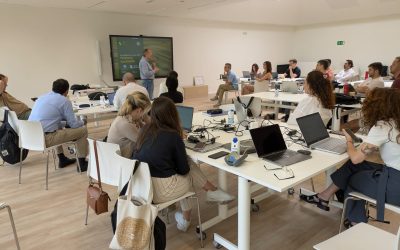The following post has been written by Miguel Carrillo Pacheco, Project Manager at Telefonica R&D. We would like to thank him for his participation and his willingness to collaborate.
It seems like it was yesterday, but it was back in the summer of 2013 when Mrs Neelie Kroes, former Vice-President of the European Commission, officially launched the FIWARE Lab in Campus Party London. People saw the flashes, the CEOs giving speeches and the large audiences in great auditoriums. But … what stood behind the cameras?
To understand what made it possible we must know that a key partner joined the FIWARE consortium in June 2012, a year before launching the FIWARE Lab. Red.es manages RedIRIS, the National Research and Education Network (NREN) in Spain, so they already had the know-how and experience required to provide the connectivity and the housing of servers of FIWARE Lab’s first node. Better still, they are in a company-neutral position as they are a governmental entity, related to the Spanish Ministry of Industry, Energy and Tourism. Once Red.es learned about FIWARE, they enthusiastically supported us and, after the usual formal steps, they joined the consortium. You cannot imagine how much effort and determination it takes to build a new lab from scratch, and especially one of this magnitude: procurements of network switches and computing nodes, creation of data center facilities able to house them, network setup… Also, we needed the contribution of other public entities which were crucial for our success. Depending on the case, they contributed with room for the labs or even with computing capacity. We are speaking about the University of Cantabria and both the Seville and Malaga City Councils in a first phase, the University of Las Palmas de Gran Canaria in a second phase. All of them in connection with Santander and Las Palmas de Gran Canaria City Councils to provide Open Data to the platform.
After thousands of emails, a first production-ready FIWARE Lab was available for the Campus Party in London. FIWARE Lab has come a long way since then, the capacity is continuously growing and new nodes are joining. And this is not only about infrastructure and GEs, many cities are willing to join us and are starting to progressively publish their Open Data via FIWARE Lab.
The second major breakthrough of FIWARE Lab was the expansion to a European network of federated nodes thanks to the XIFI project. FIWARE is twinned with this project that focuses on the uptake, deployment and federation of instances of FIWARE facilities. This is achieved via one of their major results, FIWARE Ops, a collection of tools that ease the deployment, set-up and operation of FIWARE nodes expanding an existing FIWARE instance such as the FIWARE Lab, or the creation of new FIWARE instances.
Today, FIWARE Lab has turned into a truly pan-European network of federated nodes that keeps on growing to multiple locations (expected to reach 3000+ cores, 16TB+ Ram, 750TB+ HD soon). Users can decide on what location/node to deploy their service. All of the nodes are accessible by a single user portal and work in the same way, no matter where you are! Putting together current nodes and future incorporations, we already have many nodes: Spain, Trento, Lannion, Waterford, Berlin, Mexico, Zurich, Budapest, C4I, Karlskrona, Gent, Prague, two locations in the Athens area, Volos, Stockholm, Poznan, Crete, …
Wait! Did we say pan-European? We’d better say GLOBAL. Yes, a Mexican node comprising 1200+ servers funded by Infotec and Conacyt recently joined the FIWARE Lab and it is one of its more prominent nodes from October 2014 onwards. We are in talks with new incorporations from Brazil, Chile, Japan …
This is just the beginning; let us see what the future brings.



